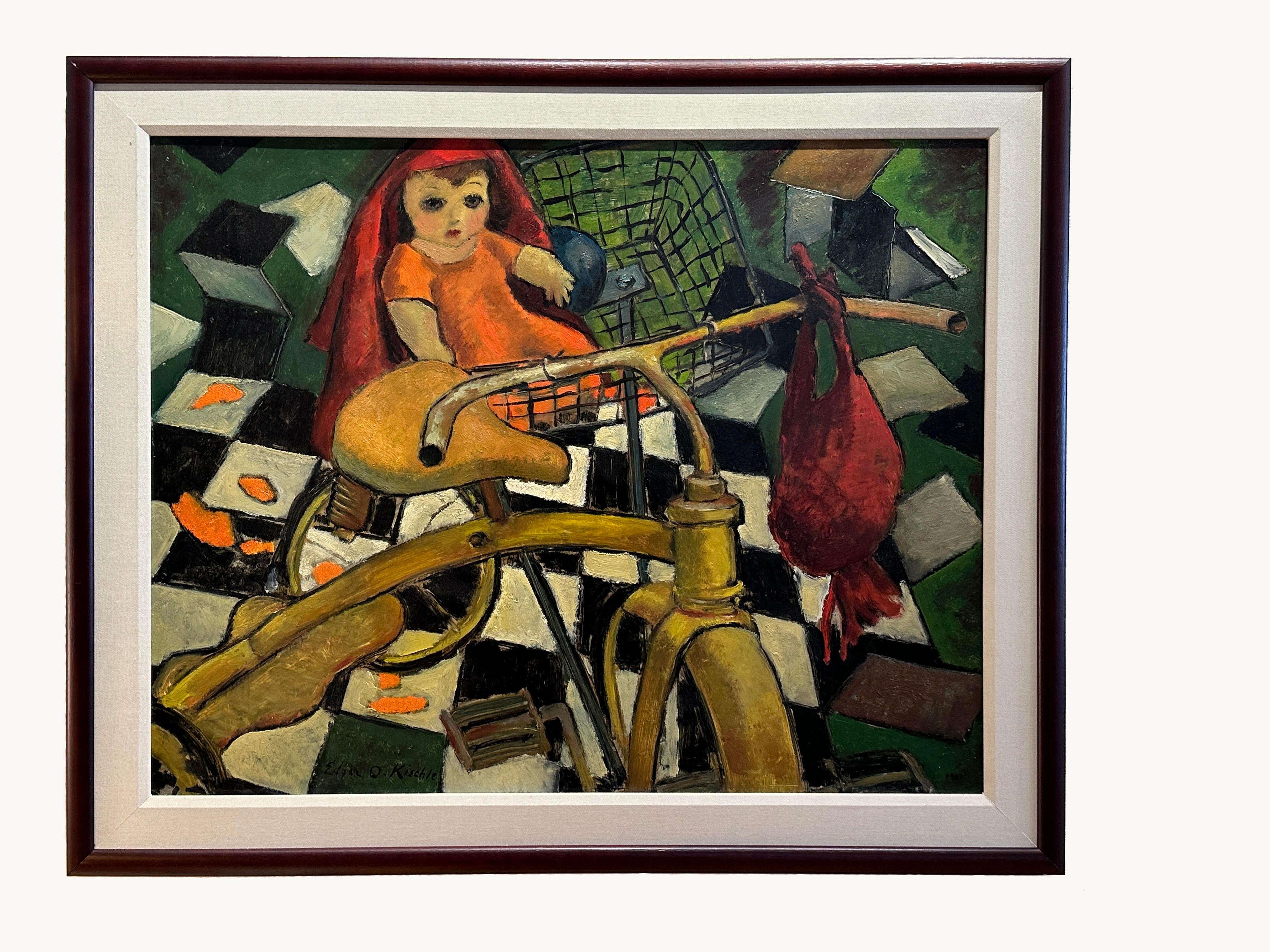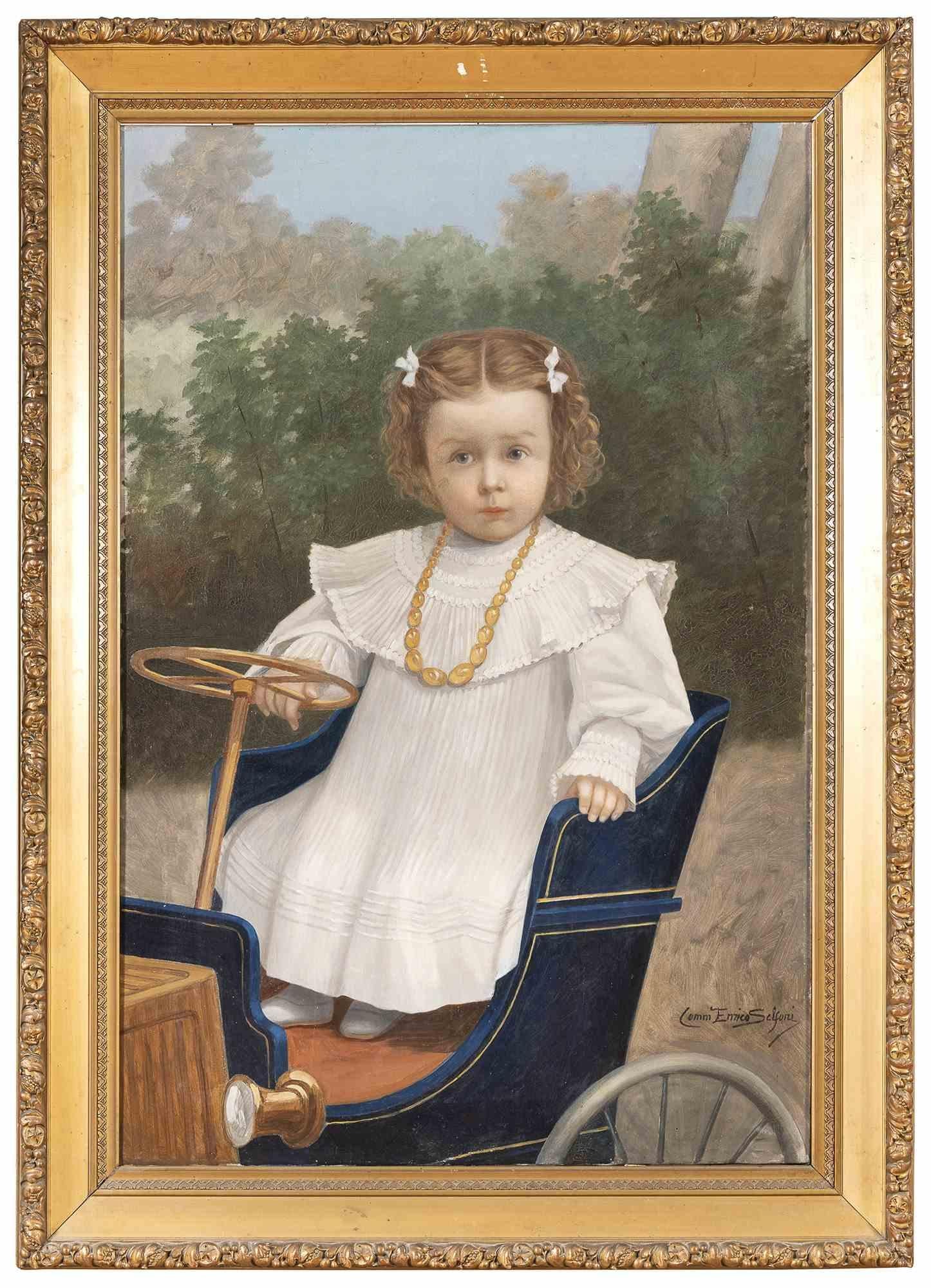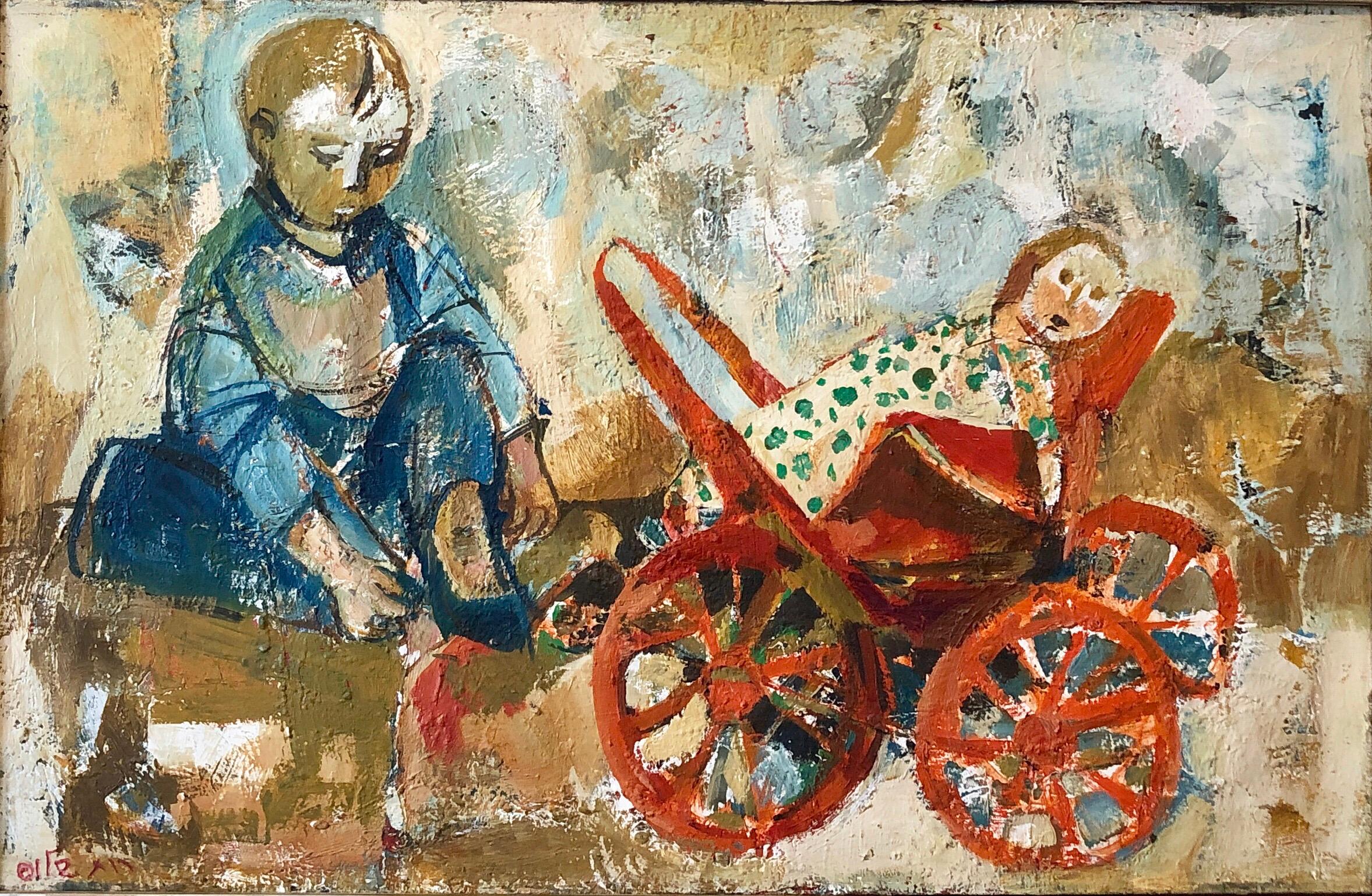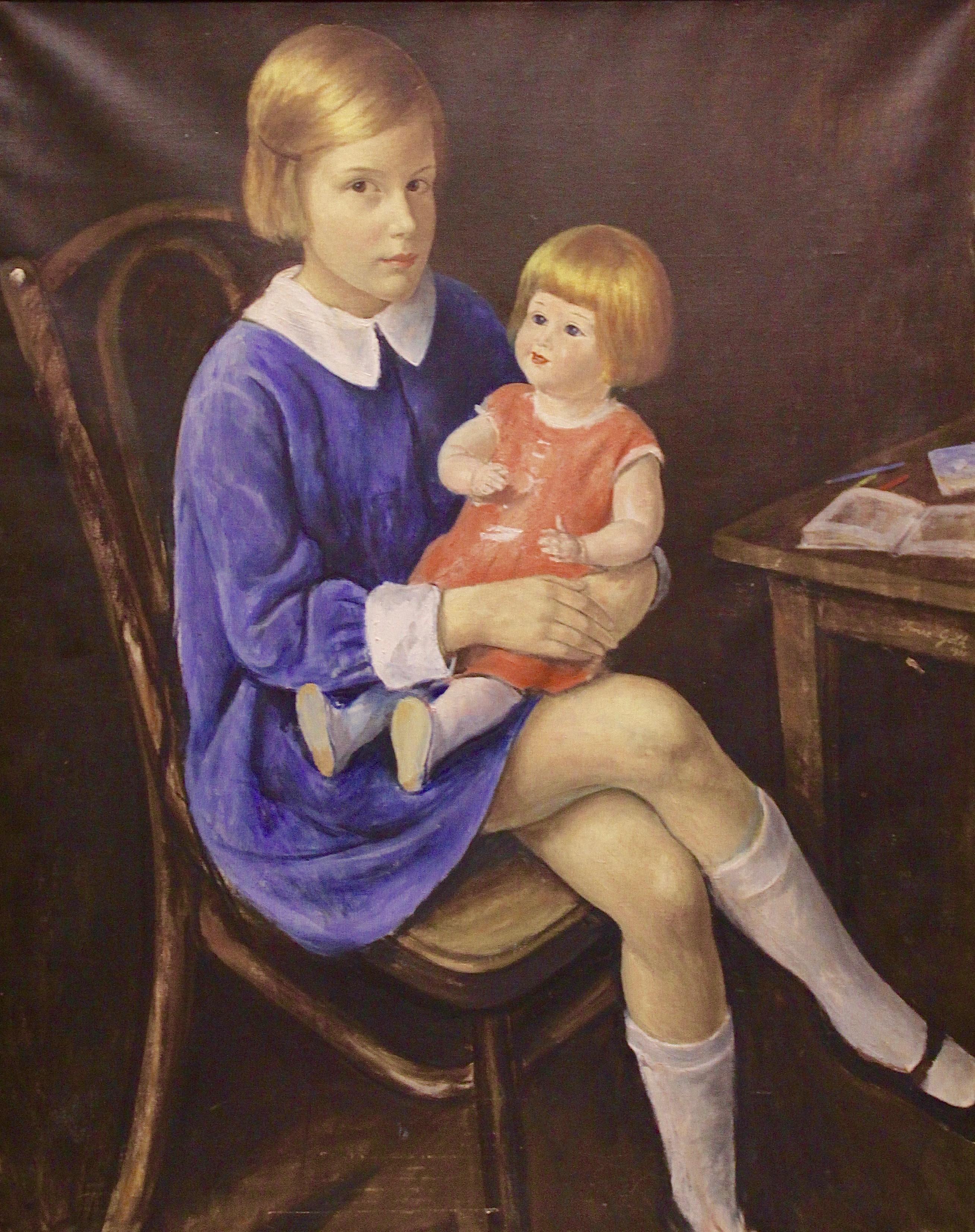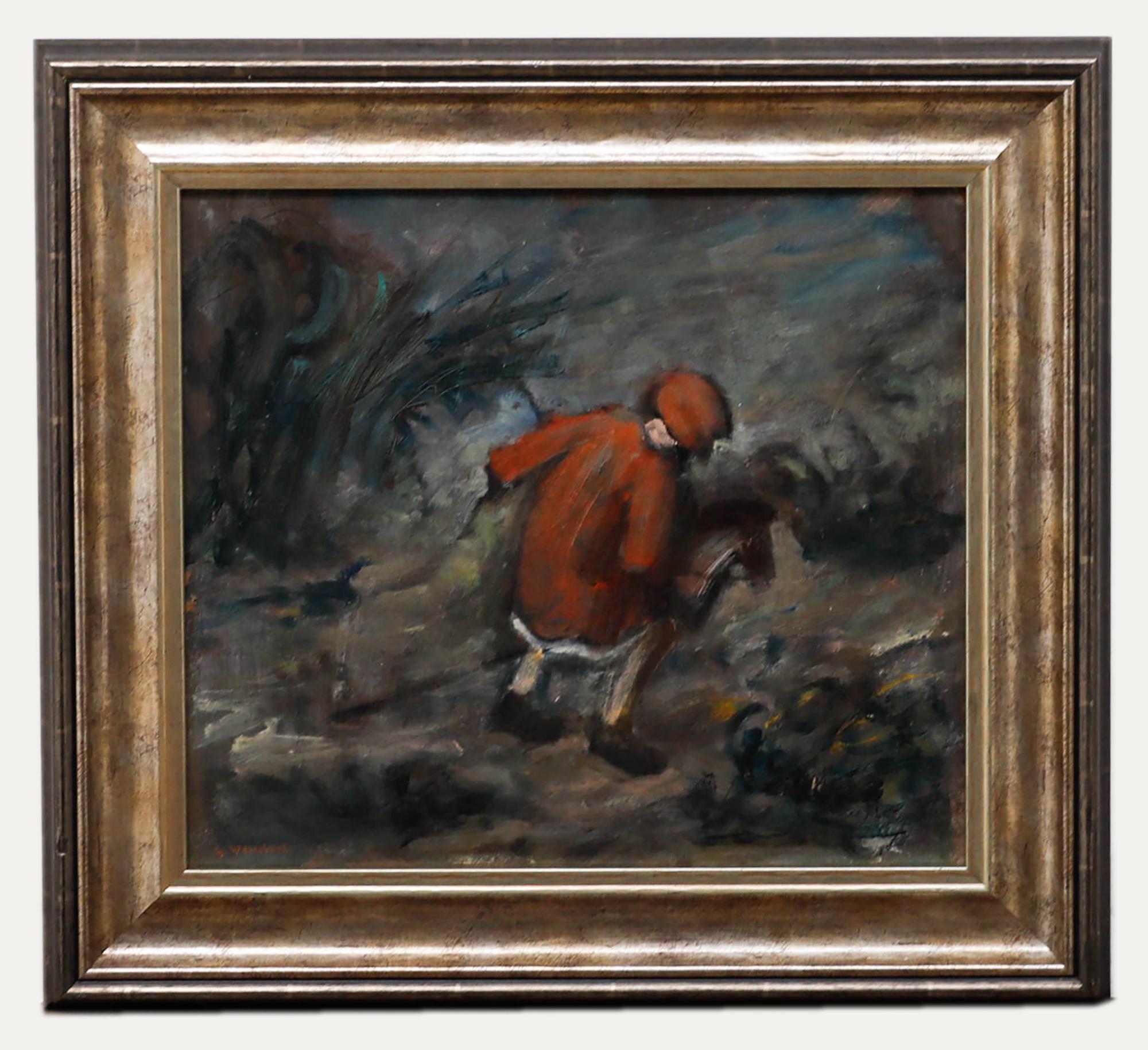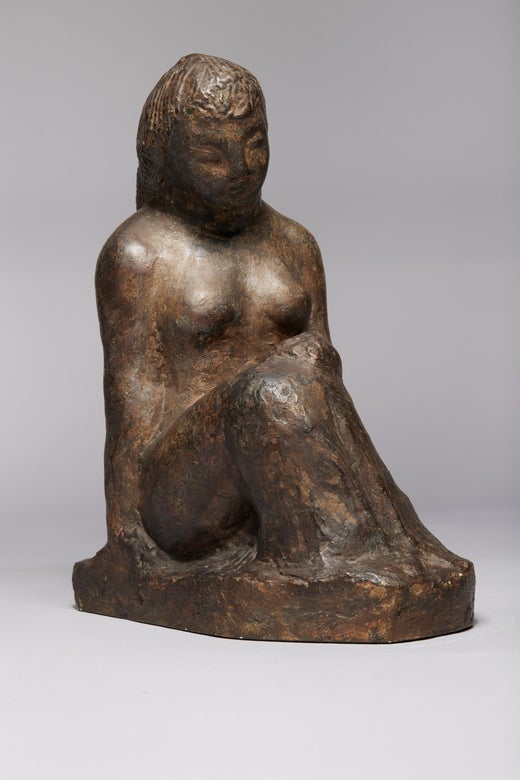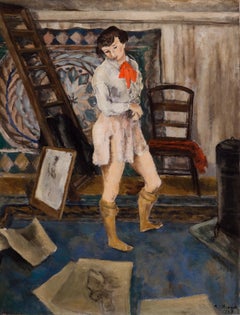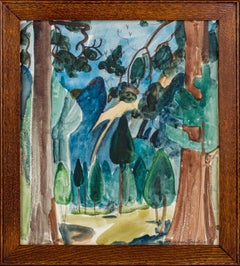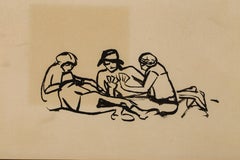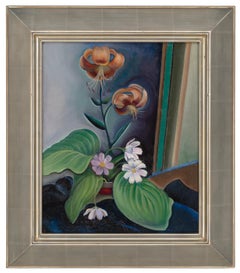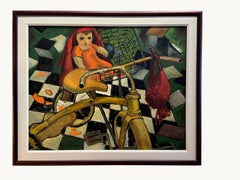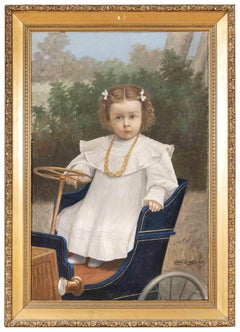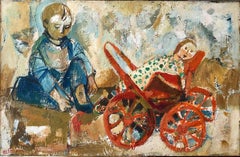Items Similar to William Zorach Oil on Canvas Painting Titled "Kiddie Kar", Dated 1920
Want more images or videos?
Request additional images or videos from the seller
1 of 5
William ZorachWilliam Zorach Oil on Canvas Painting Titled "Kiddie Kar", Dated 19201920
1920
$24,000
£18,291.87
€20,908.78
CA$33,766.49
A$36,990.14
CHF 19,470.17
MX$441,487.01
NOK 248,195.38
SEK 226,887.98
DKK 156,184.85
About the Item
Kiddie Kar exemplifies the integration of the primitive aesthetic and the depiction of family in William’s work. The primitive aspect of this particular painting is apparent in its deep, warm palette, its simplified and abstracted depiction of nature, and the slight flattening and upturning of the picture plane. The child featured in this painting is postured in a stiff, disjointed way that reflects the awkward mobility of a child. Her skin, clothes, hair and posture are highly stylized, and composed from a brushy and impastoed, application of color. Her almond shaped eyes are a deep black, recalling the simplified features of early Greek and African sculpture. This painting was preceded and succeeded by several terra cotta and wood-carved sculptures, produced between 1918 and 1923, of William’s daughter on the Kiddie Kar.
Provenance:
The artist
By descent in the artist’s family
- Creator:William Zorach (1887 - 1966, American)
- Creation Year:1920
- Dimensions:Height: 23.25 in (59.06 cm)Width: 24 in (60.96 cm)Depth: 3 in (7.62 cm)
- Medium:
- Period:
- Condition:
- Gallery Location:New York, NY
- Reference Number:1stDibs: LU2157211686942
William Zorach
Born in 1887, by 1930, he was one of America’s premier 20th century sculptors and was honored with multiple commissions and exhibitions including at the Art Institute of Chicago, the Dallas Museum of Fine Art, the Whitney Museum of American Art, and numerous others. He studied in New York City at the National Academy of Design and also in Paris under the mentoring of Jacques-Emile Blanche. It was in Paris in the first decade of the 20th century where Zorach’s path crossed with Marguerite, his soon to be wife. Both Marguerite and William were both represented in the landmark Armory Show of 1913. William continued to paint for the next two decades, but increasingly experimenting with sculpture. By the mid 20’s he was carving significant works in marble and stone. By the early 30’s, he abandoned painting entirely in favor of a new art form, sculpture. I t was in sculpture that Zorach found his true voice as an artist and achieved considerable success. “Sculpture, direct carving, was an expanding universe, a liberation and a natural form of expression to me.” Zorach stated. Museum Collections: Amon Carter Museum of American Art
Arizona State University Art Museum
Boca Raton Museum of Art
Butler Institute of American Art
Cleveland Artists Foundation
Colorado Springs Fine Arts Center
Cornish Colony Museum
Dallas Museum of Art
Delaware Art Museum
Edwin a Ulrich Museum of Art
Farnsworth Art Museum
Flint Institute of Arts
Frederick R Weisman Art Museum
Georgia Museum of Art
Herbert F Johnson Museum of Art
Jack S Blanton Museum of Art
LaSalle University Art Museum
Los Angeles County Museum of Art
Lowe Art Museum
Marion Koogler McNay Art Museum
Memorial Art Gallery
Metropolitan Museum of Art, NYC
Middlebury College Museum of Art
Minneapolis Institute of Arts
Mobile Museum of Art
Museum of Fine Art-Boston
Pennsylvania Academy of the Fine Arts
Portland Museum of Art
Smithsonian Museum of Art
The Brooklyn Museum of Art
The Canton Museum of Art
The Columbus Museum of Art-Ohio
The Columbus Museum-Georgia
The Cummer Museum Of Art & Gardens
The Currier Museum of Art
The Nelson-Atkins Museum of Art
The Newark Museum
The Phillips Collection
The Phillips Museum of Art
The University of Michigan Museum of Art
Whitney Museum of American Art
Worcester Art Museum
Yosemite Museum
About the Seller
No Reviews Yet
Vetted Professional Seller
Every seller passes strict standards for authenticity and reliability
1stDibs seller since 2022
- ShippingRetrieving quote...Shipping from: New York, NY
- Return Policy
More From This Seller
View AllAlexander Brook Oil on Canvas Painting Titled "The Artist's Model", Dated 1928
By Alexander Brook
Located in New York, NY
A model standing in a studio putting on, or taking off, her clothing.
Category
1920s Portrait Paintings
Materials
Canvas, Oil
Watercolor Painting by William Zorach, Titled "Redwoods, Yosemite Valley", 1920
By William Zorach
Located in New York, NY
William Zorach, 1887-1966
Redwoods, Yosemite Valley, 1920
Watercolor and pencil
15 ¾ x 13 ⅜ inches
Signed (at lower right): William Zorach
WZorach-7
Provenance:
Estate of William Zorach
Exhibited:
William Zorach, 1887-1996, Sculpture, Drawings and Watercolors, Zabriskie Gallery, New
York; Feb. 10 – March 14, 1998.
William Zorach was born in Lithuania in 1889, and immigrated to the United States with his
family in 1893. Settling in Cleveland with his parents, he worked as a lithographer from 1902-
1908, making enough money to study painting with Henry G. Keller at the School of Art. In
1910, Zorach traveled to Paris to study in La Palette, where he was encouraged to develop his
own unique style rather than adhere to traditional teachings. Zorach once said, “I began to be
conscious of the various modern influences that were invading the art world…I was disturbed
and confused, and yet I felt that I was a very young man entering a new age. The forces creating
modern art seemed more alive to me than anything I had known or anything being done in
America.” 1 Together with his wife Marguerite, William Zorach produced a number of Cubist-
style paintings for the American Armory Show of 1913, and the Forum Exhibition in New York
in 1916.
Around 1917, Zorach followed the lead of cubist artist Pablo Picasso and began experimenting
with wood and stone carvings. By 1922, he devoted himself entirely to sculpture, and like
Picasso, became fascinated in “primitive art”—the ritual objects and sculpture pieces of Oceanic,
Native American and African tribes. Zorach’s work developed in its use of block-like forms with
progressive suppression of detail—drawing elements from sources as disparate as the
contemporary cubist and modernist movements, and combining them with forms seen in early
African sculpture. Though the forms of his sculpture were often abstract, Zorach primarily
focused upon a traditional subject matter, producing such well-known sculptures as Young Girl,
now in the Whitney Museum of American Art, and Mother and Child, in the collection of the
Metropolitan Museum of Art. Today, William Zorach is known as one of the earliest and most
influential American artists dedicated to direct carving. Zorach also made an impression as a
teacher and writer, facilitating a major change in the aesthetic philosophy and technique of
sculpture in the United States.
During the summers from 1913 to 1922, Zorach and his wife Marguerite painted...
Category
1920s Landscape Drawings and Watercolors
Materials
Watercolor, Pencil
Drawing on Paper Titled "The Card Game" by Marguerite Zorach, 1912
Located in New York, NY
Marguerite Zorach, 1887-1968
The Card Game, 1912
Ink on paper
9 ¼ x 12 inches
Signed and inscribed (on verso): Marguerite Zorach Playing Cards/Calif./1912.”
ZoraM-02
Category
1910s Figurative Drawings and Watercolors
Materials
Paper, Ink
Mathias J. Noheimer Oil on Canvas Painting of a Still Life, ca. 1935
Located in New York, NY
Mathias J. Noheimer (American 1909-1982)
Still Life, ca. 1935
Oil on canvas
Signed Noheimer, center right
Provenance:
Mitchell Brown Fine Art Inc., Scottsdale, AZ
Private collection...
Category
1930s Still-life Paintings
Materials
Oil
Frank Judge Oil on Board Painting Titled "Miss St. Louis", circa 1940
Located in New York, NY
A bright portrait of a woman in pageant dress before a St. Louis skyline and riverboat.
Category
1940s Figurative Paintings
Materials
Oil, Board
Gouache and Graphite Drawing on Board by Lois Field, Dated 1947
Located in New York, NY
Lois Field (Am. 1923 - 2010)
Untitled
Gouache and graphite on board, 1947
11 3/4” x 9”
Signed and dated Lois Field ‘47, lower left
Provenance
The artist, Webster Groves, MO (ca. 200...
Category
1940s Abstract Drawings and Watercolors
Materials
Gouache
You May Also Like
" Tricycle and Doll" Oil on Canvas by Edgar Kiechle
Located in Pasadena, CA
This figurative painting by Edgard Kiechle presents the scenario of a doll who is very surprised to have been abandoned into the basket of her mom's tricycle.
An interesting factor is the pictorial use of angles. The point of view, a little above the stage, probably that of an adult, offers particular perspectives. This approach adds depth to this painting with distinctive compositional appeal.
In contrast to the scene's disorder, a black-and-white tiled floor with a geometric design serves as an antithesis. The careful symmetry of the tiles competing with the surrounding disarray sparks a dialogue about the human need for organization and balance.
In composition, absence is a living element. The exclusion of a physical human figure amplifies the feeling of emptiness, creating a human presence perceived imaginatively.
Edgar O. Kiechle was born in 1911. He was a film illustrator and a painter.
Edgar studied landscape painting with Jean Mannheim and architecture and became an excellent watercolorist. After studying at the Otis Art Institute in Los Angeles, he interned with leading architects and designers. He worked at most major studios, but his career as an illustrator saw him primarily at the Universal Studio Art department.
In 1933, Edgar joined Lwerks as a background artist and worked on many films produced by Animated Picture Corporation through 1935.
In the summer of 1941, Edgar Kiechle...
Category
Mid-20th Century Figurative Paintings
Materials
Oil, Canvas
$398 Sale Price
75% Off
Portrait of Child on a Car - Oil Painting - Late 19th Century
Located in Roma, IT
Portrait of Child on a Car is an original moder artwork realized between the late 19th and the 20th century by an italian Master.
Mixed colored oil...
Category
Late 19th Century Modern Figurative Paintings
Materials
Oil
Israeli Oil Painting Ruth Schloss Child, Doll, Wagon, Kibbutz Social Realist Art
By Ruth Schloss
Located in Surfside, FL
Large magnificent colorful Ruth Schloss oil painting of a child with a wagon with a doll or a baby in a carriage stroller.. Signed in Hebrew
size measures 31x43 with frame , 23x35.25 without the frame. (this is being sold unframed).
Ruth Schloss (22 November 1922 – 2013) was an Israeli painter and illustrator who mainly depicted neglected scenes such as Arabs, transition camps, children and women at eye-level as egalitarian, socialist view via social realism style painting and drawing.
Schloss became Israeli painting’s sensitive, conscious, remembering eye.
Ruth Schloss was born on 22 November 1922, in Nuremberg, Germany, to Ludwig and Dian Schloss, as the second of three daughters of bourgeois assimilationist Jewish family well-integrated into German culture. As the Nazis came into power in 1933, her family immigrated to Israel in 1937, and settled in Kfar Shmaryahu, then an agricultural settlement. Schloss studied at the Department of Schloss graphic design at "Bezalel" from 1938 to 1942 alongside Friedel Stern and Joseph Hirsch. She was a realistic painter who focused on disadvantaged people in the society and social matters as an egalitarian. Her realism was thus an “inevitable realism,” motivated by an inner necessity: the need to observe reality as it is.
Her painting repeatedly addressed the door pulled from its frame, employing drawing’s unique ability to stop time and prolong the image’s persistence in the retina, she repeatedly committed to paper - in a matter-of-fact, non-evasive manner devoid of mystery – man’s tendency to generate chaos, suffering and pain.
Throughout her life, Schloss remained minimalist. Painting about human fate was the main subject of her artworks. Her natural inclination was to describe the darker aspect of human existence.
1930s
The Schloss household was characterized by open, liberal spirit, in keeping with the parents’ progressive views. It deeply influenced Ruth’s mental development, as she learned to tie culture and art with sensitivity towards the weak and underprivileged.
In Jerusalem, she joined a commune of Hashomer Hatzair in which she shaped her socialist views, which she maintained throughout her long career.
1940s
In this period she mainly depicted landscapes of kibbutz and wretched women living hard life, children in huger, older people, refugees. After completing her art studies, Schloss joined a training group at Kibbutz Merhavia in 1942, and after two years moved to Karkur region, the nucleus established Kibutz Lehavot Habashan in the Upper Galilee. Through this time, she fell in love with the surroundings and drew landscapes. They are simple and direct with fresh, lucid lines. These paintings were selected as the main works of her first exhibition in 1949.
In early 1945, Schloss started to draw illustrations in the children’s magazine Mishmar Leyeladim, and designed the logo of Al Hamishmar, the paper’s new name in 1948. In 1948, upon the founding of Mapam (United Workers’ Party), she designed her party’s emblem, which became a well-known icon. She kept working as an illustrator for Mishmar Layeladim until 1949.
"Mor the Monkey" project yielded financial profits and this income was used for a study trip to Paris for two years. She was succesfull as illustrator however, she had inner conflicts of her identity as witnessed painter toward neglected class in Israeli society.
First Exhibition at Mikra-Studio Gallery, 1949
She presented forty drawings on paper in her first solo exhibition, representing a selection of the themes of kibbutz landscape, its lifestyle. Schloss confidently proposed her direction through simplicity without using colors in her drawings.
1950s
Between 1949 and 1951, she studied at the Académie de la Grande Chaumière in Paris.
She began working in oils, with which she continued throughout the 1960s.
The exhibition “Back from Paris” opened in November 1951 at Mikra-Studio Gallery .
In 1951 she married Benjamin Cohen, who served as chairman of the national leadership of Hashomer Hatzair Workers Party in Tel Aviv. He was a theoretician and a man of principle, highly esteemed by its leaders who became a professor of history at Tel Aviv University. In 1953, following the Mordechai Oren affair and the publication of Moshe Sneh 's followers from Kibbutz Artzi, she and her husband left the kibbutz and moved to the agricultural farm, Kfar Shmaryahu, where she lived until her death.
At a certain point in Israeli history, segments of the socialist movement felt that Israel should become part of the Communist bloc, rather than seek the support of the western world. Because the Schloss couple support of Moshe Sneh’s left-wing party, they had to leave the kibbutz.
She loved to depict ordinary women as figurative on her painting without hiding or making up anything. The poet Natan Zach wrote about her works in 1955: “Her motto remains that which has been all these years: life as it is, without bluffing."
Schloss’s “Pietà” (1953) became a universal cry expressing the pain of mothers on either side of the divide. In the late 1950s, she was the mother of two daughters. When she drew her daughters, unlike the universal babies she depicted, naked and with clenched fists, the painting of her children employed babyish sweetness to the full in a quiet, peaceful and heart-stirring filling rather than urgency. She also painted children in the transition camp and Jaffa in the 1950s and 1960s.
1960s-1980s – The period of Studio in Jaffa
Schloss painted at a studio in Jaffa from 1962 till 1983. In this time, she turned her interest to people around her more than kibbutz – the children, mothers, and poor workers, the alleys and houses. She opened the space to the street and its dwellings, built interactions around it, and was nurtured by the presence of the outside in her work.
1960s Schloss familiarized to an Arab woman, Nabava, lived in poor. Schloss returned to painting images of old people later, and she called her painting figurative elderly people in the old age homes “waiting”.
In the late 1960s, Ruth discovered acrylic paint and never turn back to oil painting.
In 1965 Schloss devoted a series “Area 9 (1965)”, dedicated to the demolition of Israeli-Arab houses and the expropriation of the land, and carried a definite socio-political messages. The series was exhibited at Beit Zvi, Ramat Gan, in 1966. She was the only artist who addressed the result of the Six-Day War immediately afterward. In 1968, Schloss and Gansser-Markus presented “Drawing of War” in Zurich gallery. She expressed the war as an ultimate expression of destruction and ruin, regardless of victors and vanquished.
1970s In late 1970s Schloss began printing the selected photograph directly on the canvas, posterior reworking it in acrylic. She decided to print her work at Har-El Printers in Jaffa, and these became the surface of her painting. This technique was mainly adopted in two large series: Anne Frank (1979-1980) and Borders (1982). Through this technique she placed the figure of elder Frank next to that of the famous young Frank, and released it at the exhibition at Bet Ariela Cultural Center, Tel Aviv, in 1981. The series touched upon the Nazi Holocaust.
1980s The Lebanon War raised the question of “The Good Fence” and the effect of the war. She dedicated a large series Boarders, one of the most powerful image linked to the series is the figure of Yemenite woman raising her hand. She was the first to raise the Black Panthers demonstration to the level of a social icon. In the 1980s and again in 2000, the Intifada uprisings also led Schloss to the easel to render a good number of representational and symbolic works that in their way denounced Israel's political and military actions.
1990s – 2000s Ruth Schloss never had an exhibition in a major Israeli museum. Her works were presented in private galleries and small museums. The main museums, the Tel Aviv Museum of Art and the Israel Museum, included her works only in group exhibitions, and only in 1991 was her retrospective exhibited at the Herzliya Museum.
In the 2000s, Schloss’s metaphors turned into animal kingdom and Bedouins in the south. A huge rhinoceros, birds of prey, and other "bad animals," as Cohen Evron, daughter of Ruth, calls them and "I connected this to the Nazis," said Schloss. Schloss' work after she didn't find human expression able to transmit the endless cruelty she saw in Israel's political mentality.
Schloss also continued to follow and collect documentary photographs of destructions of houses from the war, the Intifada, the sequence of her work about ruin from 1949 to 2005, was a cumulative testimony about the painful history of Israel and Palestine.
In 2006, a large retrospective exhibition of her work was presented at the Museum of Art in Ein Harod, curated by Tali Tamir.
Education
1938-41 Bezalel Art Academy, Jerusalem, with Mordecai Ardon
1946 painting course for Kibbutz Artzi artists with Yohanan Simon and Marcel Janco
1949-51 Académie de la Grande Chaumière, Paris
Awards and recognition
1965 Silver Medal, International exhibition in Leipzig, Germany
1977 Artist-in-Residence, The Cité Internationale Universitaire de Paris
Selected solo exhibitions
2004 “Micha...
Category
Mid-20th Century Realist Figurative Paintings
Materials
Canvas, Oil
Theodor Schindler "Still Life with Toys 1910" German Impressionism
Located in Eltville am Rhein, DE
Theodor Schindler
Malsch 1870 - 1950
Still Life with Toys, 1910
Oil on canvas
Signed and dated upper left
Size: approx. 58.5 x 74.5 cm
Frame: approx. 67 x 82 cm
Viewing and collec...
Category
1910s Still-life Paintings
Materials
Oil
Imre Goth, 1893-1982, Hungary, "Little lady with doll" Oil on canvas circa 1931
By Imre Goth
Located in Berlin, DE
Large, enticing and very decorative painting.
Oil on canvas. Signed Imre Goth 1931.
1931. Motif of an elgant, young girl with her doll.
Beautiful painting in impressionist style.
...
Category
Early 1900s Impressionist Figurative Paintings
Materials
Canvas, Oil
$42,991 Sale Price
20% Off
George Weissbort (1928-2013) - Framed 20th Century Oil, Child with Hobby Horse
By George Weissbort
Located in Corsham, GB
This dynamic oil painting captures a young child in a red coat and cap, moving swiftly on a hobby horse through tall reeds. The loose brushwork and muted colour palette create a sens...
Category
20th Century Landscape Paintings
Materials
Oil
More Ways To Browse
Antique Greek Painting
Contemporary Painting Car
Naive French Folk Art Painting
African Faces
Modern Judaica Painting
Red Bull
Surreal Figure
Army Painting
Classical Figurative Paintings
The Kiss Painting
David Manning
French Impressionist Sketch
La Madeleine
Russian Palace
Vintage Ballerina Painting
Antique Painting Of Children
Egg Tempera Contemporary Painting
Oil Painting Xix
